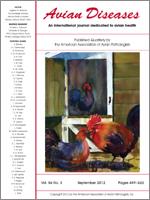This study examined the effects of fumonisin B1 (FB1) and moniliformin (M) on the heart of Japanese quail (Coturnix coturnix japonica). Three hundred and ninety day-old Japanese quail were randomly divided into four groups: 1) FB1 alone (FX), 2) M alone (MX), 3) FB1 and M (FM), and 4) chick mash alone (CX). We used three pen replicates of 35 quail per pen in groups FX, MX, and FM and three pen replicates of 25 quail per pen in group CX. Gross and microscopic changes in the heart were studied in nine birds (three birds per replicate) from each group at weekly intervals up to 28 days postfeeding (DPF). Ultrastructural changes were studied in the heart of three birds (one bird per replicate) from each group at 21 DPF. Thinning of the heart was the only significant gross lesion in group FX. In contrast, mild-to-severe cardiomegaly was a significant finding in groups MX and FM throughout the study. Microscopically, thinning of cardiomyocytes was evident at 7 DPF in group FX. In addition to the hypertrophy of cardiomyocytes evident as early as 7 DPF, myocardial karyomegaly, nuclear hyperchromasia, and myofibril disarray exhibiting a wavy pattern were more pronounced at 28 DPF in group MX. Similar but more severe lesions were observed in the FM combination group that included myocardial hemorrhages, vacuolar changes, hypertrophy of cardiomyocytes, focal myocarditis, and loss of myofibrils cross-striations. Via transmission electron microscopy, the maximum effect of FB1 toxicity was observed on mitochondria. In addition to an increase in the number of mitochondria, the mitochondria seemed invariably swollen and pleomorphic, although the outer membrane was intact, and the membrane cristae were usually distinct. Myofibrils seemed thinner, without much disruption in their architecture. Large numbers of vacuolar bodies of irregular size, both in the sarcoplasm and in between the myofibrils, were conspicuous in group FX. In contrast to group FX, the increase in number of mitochondria resulted in widespread separation of muscle fibers in group MX. In addition, the mitochondria were swollen and varied from round to oval to slightly elongated and occasionally forked, and vacuolation was rarely noticed in group MX. In the FM combination group, a significant increase in the number of mitochondria caused muscle fibers to look much thinner and assume a wavy pattern. We conclude that the effect of M on the heart is exaggerated in the presence of FB1. Although the overall interactive effect of FB1 and M was less than additive, the interactive effects between the two toxins for cardiac lesions were greater than additive to synergistic up to the second week, raising serious concerns on early age exposure to a combination of these two mycotoxins.
How to translate text using browser tools
1 September 2012
Toxic Interaction Between Fumonisin B1 and Moniliformin for Cardiac Lesions in Japanese Quail
Deepa Sharma,
R. K. Asrani,
D. R. Ledoux,
G. E. Rottinghaus,
V. K. Gupta
ACCESS THE FULL ARTICLE

Avian Diseases
Vol. 56 • No. 3
September 2012
Vol. 56 • No. 3
September 2012
Fusarium fujikuroi culture material fumonisin B1
Fusarium verticillioides culture material
heart
Japanese quail
moniliformin
pathology




